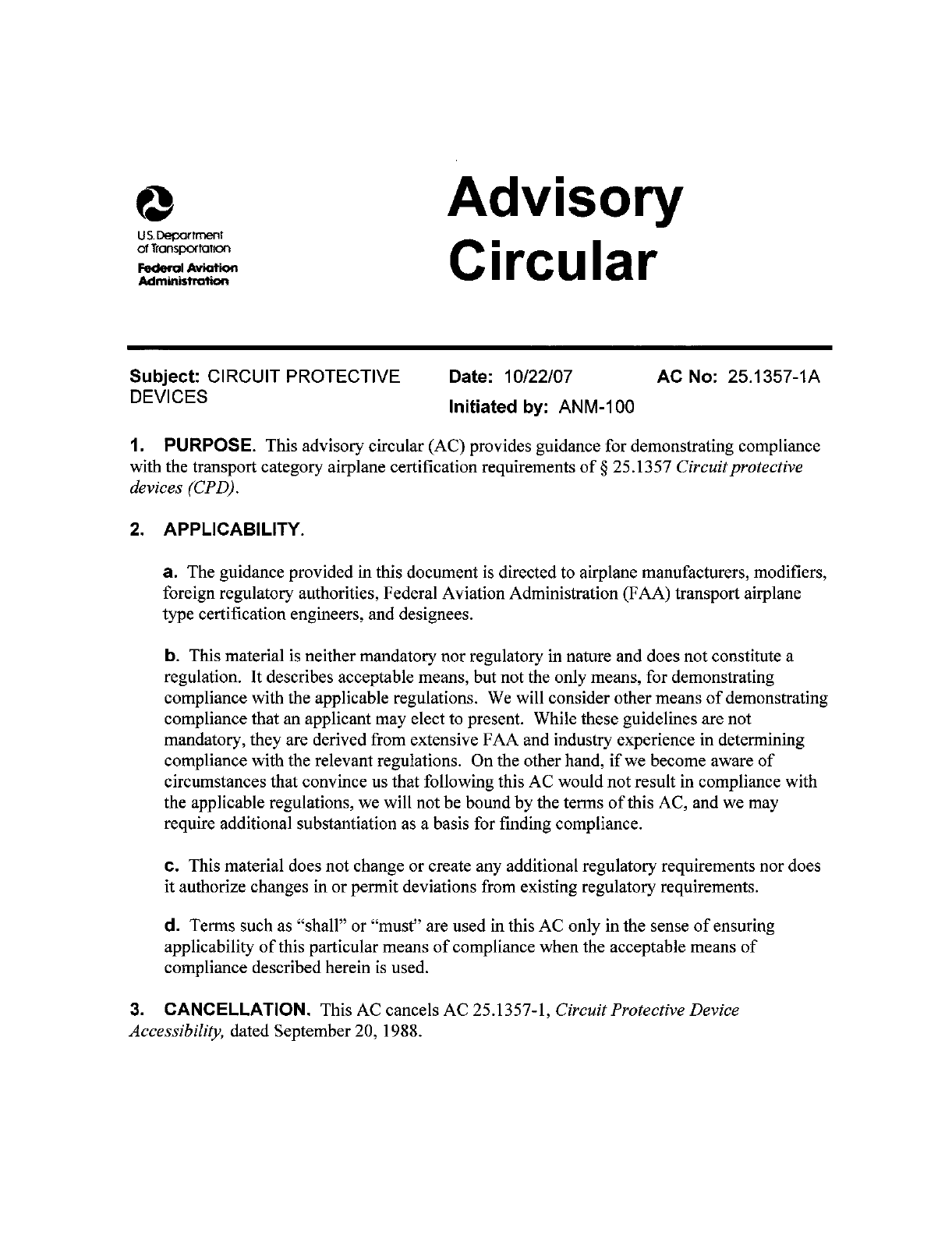
© Advisory
US.
Department
of Transportation
Federal Aviation
Circular
Administration
Subject: CIRCUIT PROTECTIVE Date: 10/22/07 AC No: 25.1357-1A
DEVICES Initiated by:
ANM-100
1.
PURPOSE. This advisory circular (AC) provides guidance for demonstrating compliance
with the transport category airplane certification requirements of
§
25.1357 Circuit protective
devices (CPD).
2.
APPLICABILITY.
a. The guidance provided in this document is directed to airplane manufacturers, modifiers,
foreign regulatory authorities, Federal Aviation Administration (FAA) transport airplane
type certification engineers, and designees.
b.
This material is neither mandatory nor regulatory in nature and does not constitute a
regulation. It describes acceptable means, but not the only means, for demonstrating
compliance with the applicable regulations. We will consider other means of demonstrating
compliance that an applicant may elect to present. While these guidelines are not
mandatory, they are derived from extensive FAA and industry experience in determining
compliance with the relevant regulations. On the other hand, if we become aware of
circumstances that convince us that following this AC would not result in compliance with
the applicable regulations, we will not be bound by the terms of this AC, and we may
require additional substantiation as a basis for finding compliance.
C. This material does not change or create any additional regulatory requirements nor does
it authorize changes in or permit deviations from existing regulatory requirements.
d. Terms such as "shall" or "must" are used in this AC only in the sense of ensuring
applicability of this particular means of compliance when the acceptable means of
compliance described herein is used.
3.
CANCELLATION, This AC cancels AC
25.1357-1,
Circuit Protective
Device
Accessibility, dated September
20,
1988.
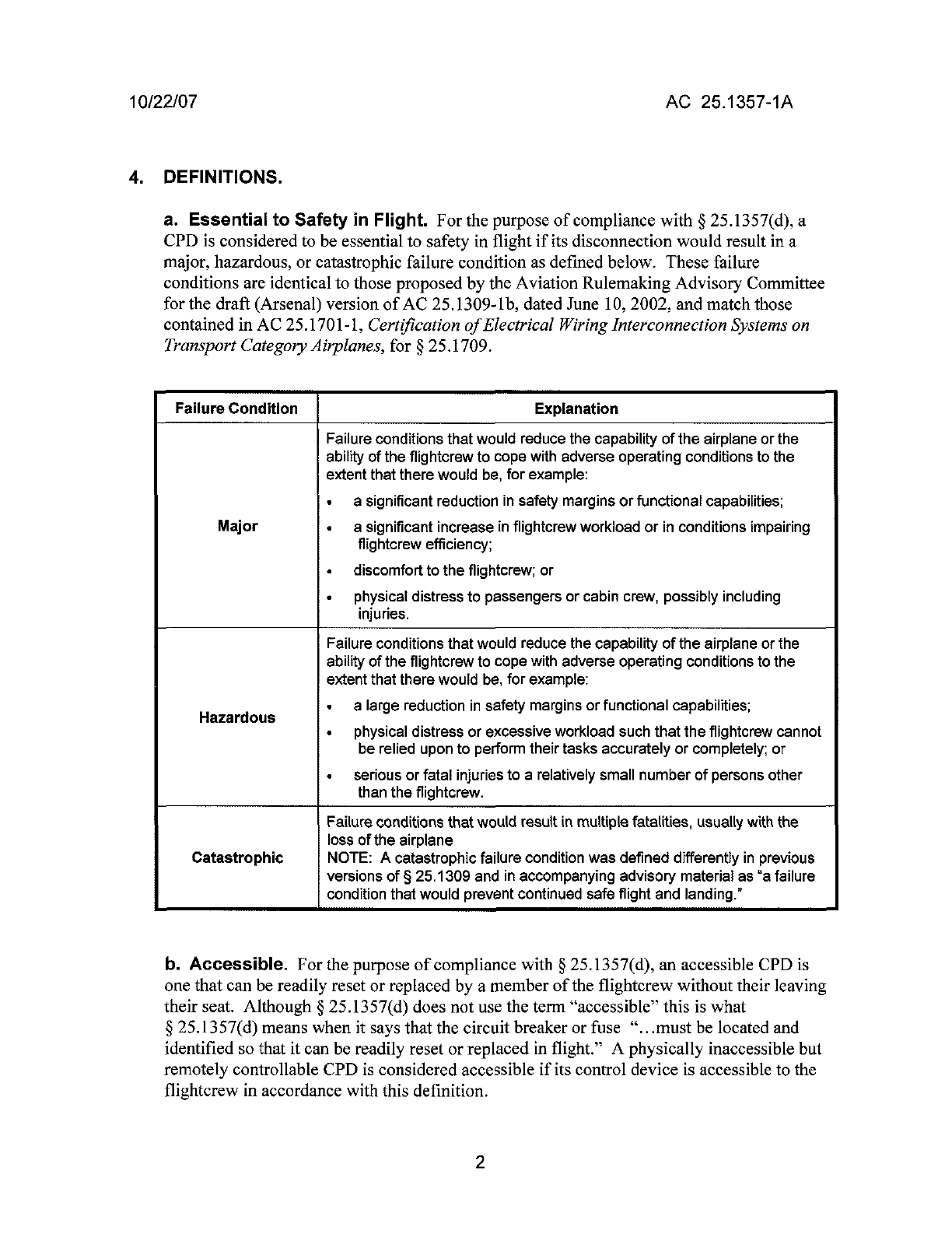
10/22/07
AC 25.1357-1A
4. DEFINITIONS.
a. Essential to Safety in Flight. For the purpose of compliance with § 25.1357(d), a
CPD is considered to be essential to safety in flight if
its
disconnection would result in a
major, hazardous, or catastrophic failure condition as defined below. These failure
conditions are identical to those proposed by the Aviation Rulemaking Advisory Committee
for the draft (Arsenal) version of AC
25.1309-lb,
dated June 10, 2002, and match those
contained in AC
25.1701-1,
Certification
of Electrical
Wiring Interconnection Systems
on
Transport Category
Airplanes,
for § 25.1709.
Failure Condition Explanation
Failure conditions that would reduce the capability of the airplane or the
ability of the flightcrew to cope with adverse operating conditions to the
extent that there would be, for example:
• a significant reduction in safety margins or functional capabilities;
Major
• a significant increase in flightcrew workload or in conditions impairing
flightcrew efficiency;
• discomfort to the flightcrew; or
• physical distress to passengers or cabin crew, possibly including
injuries.
Failure conditions that would reduce the capability of the airplane or the
ability of the flightcrew to cope with adverse operating conditions to the
extent that there would be, for example:
• a large reduction in safety margins or functional capabilities;
Hazardous
• physical distress or excessive workload such that the flightcrew cannot
be relied upon to perform their tasks accurately or completely; or
• serious or fatal injuries to a relatively small number of persons other
than the flightcrew.
Failure conditions that would result in multiple fatalities, usually with the
loss of the
airplane
Catastrophic
NOTE:
A catastrophic failure condition was defined differently in previous
versions of
§25.1309
and in accompanying advisory material as
"a
failure
condition that would prevent continued safe flight and landing."
b.
Accessible. For the purpose of compliance with § 25.1357(d), an accessible CPD is
one that can be readily reset or replaced by a member of the flightcrew without their leaving
their seat. Although
§
25.1357(d) does not use the term "accessible" this is what
§
25.1357(d)
means when it says that the circuit breaker or fuse "..
.must
be located and
identified so that it can be readily reset or replaced in flight." A physically inaccessible but
remotely controllable CPD is considered accessible if
its
control device is accessible to the
flightcrew in accordance with this definition.

10/22/07 AC 25.1357-1A
c. Electrical Wiring Interconnection Systems
(EWIS).
In part, an
EWIS
is any
wire,
wiring device, or combination of
these,
including termination devices, installed in any
area of the airplane for the purpose of transmitting electrical energy between two or more
intended termination
points.
The complete regulatory definition of an EWIS is in
§
25.1701,
which is included in Appendix A of this AC.
5. COMPLIANCE GUIDANCE.
a. Protection Against Arc Faults. Protection against faults should be provided. Arc
fault circuit breakers (AFCB) may provide one means to protect against arc faults. As of
the publication date of this AC, AFCB technology is still being developed. However, as the
technology matures and AFCBs become available, applicants should evaluate the merits of
using AFCBs in their designs.
b.
§
25.1357(a).
It should be demonstrated that no hazard results from the effects of
variations in ambient temperature on either the protective device or the equipment it
protects when selecting and designing the installation of the automatic protective devices
required by § 25.1357(a).
c. § 25.1357(d). This section requires that a CPD must be accessible if the ability to reset
or replace it is essential to safety in flight. Single failures and combinations of failures,
including automatic CPD disconnections, must be considered in defining a safe design. Any
single CPD through which continued electrical power is conducted, including those used to
protect buses or power sources, that is essential to safety in flight must be accessible to the
flightcrew without their having to leave their seats.
d.
Circuit Breaker Reset
(1) Service experience shows that attempts by the flightcrew to restore power by
resetting or replacing a CPD after its automatic disconnection can sometimes create a
fire
hazard and will often be unsuccessful because the majority of such disconnections
are caused by faults that must be corrected by maintenance action. Therefore, designs
should not require resetting or replacing CPDs in flight to cope with any failure
condition, except as part of
an
approved fault-clearing and isolation procedure in a
situation where the flightcrew believes a catastrophic event could occur if the circuit
breaker is not reset.
(2) Service experience also shows that attempts by the flightcrew to clear and isolate
faults at the individual load level can sometimes create a fire hazard, especially if the
flightcrew is unable to confidently identify the faulty circuit or component and the limits
of the faults' effects. Few circuits or components are located where such confident
determinations can be made. Therefore, designs should allow safe accomplishment of
all necessary fault-clearing and isolation procedures at the bus or power source level by
ensuring that disconnection of
any
bus or power source as part of any such procedure

10/22/07 AC 25.1357-1A
does not cause any loss of function that would result in a major, hazardous, or
catastrophic failure condition.
(3) Spare fuses. If fuses are used, this section requires a number of
spare
fuses for
use in flight equal to at least 50 percent of the number of fuses of each rating required
for complete circuit protection. This section applies only to accessible fuses.
(4) Fault-clearing and isolation procedures. The airplane flight manual (AFM)
or applicable AFM supplement should contain all fault-clearing and isolation
procedures. These procedures should be approved by the cognizant Aircraft
Certification Office or FAA designee.
e. § 25.1357(e). This section requires that "each circuit for essential loads must have
individual circuit protection." Traditionally this would mean that each circuit for an
airplane essential system would have its own dedicated circuit protective device, because
each essential airplane system would have its own power source, equipment, and wiring.
However, modern airplanes continue to increase their utilization of system architectures
containing a high level of
integration.
That means, for example, that a single piece of
avionics equipment may provide control of multiple airplane systems that are essential for
safe operation. Typically these pieces of avionics are redundant, with two or three pieces of
equipment providing for function redundancy. The traditional definition of
a
"circuit"
cannot be applied in these cases. There is not a one-to-one correspondence of power source,
control equipment, and wire for each airplane system controlled by the integrated circuit.
Therefore, in the context of this paragraph, a circuit is defined as the circuit protective
device, the equipment performing the integrated functions, and its associated
wire.
To
demonstrate compliance with the requirements of
§
25.1357(e)
in
the case of apiece of
equipment that integrates multiple functionality, the applicant must demonstrate that the
overall circuit has individual circuit protection. Note that other paragraphs, such as
§ 25.1357(a), may require that subsystems within the circuit also be provided circuit
protection.
f. § 25.1357(f). This paragraph requires that circuit breakers not be used as the primary
means to remove or reset system power for those airplane systems for which the ability to
remove or reset power during normal operation is necessary, unless specifically designed as
a switch.
(1) It is not the intent of the requirement that every electrically powered system in the
airplane have a means to remove power other than a circuit breaker. We distinguish
between airplane systems normally turned on and off during normal operations, such as
passenger convenience systems, and those systems normally powered at all times, such
as flight deck multi-function displays or the
flight-management
computer. But if, for
example, the flight-management computer did require power cycling regularly, for
whatever reason, this system would be required to have a means to do this other than
using the circuit breakers, unless the circuit breaker is specifically designed as a switch.
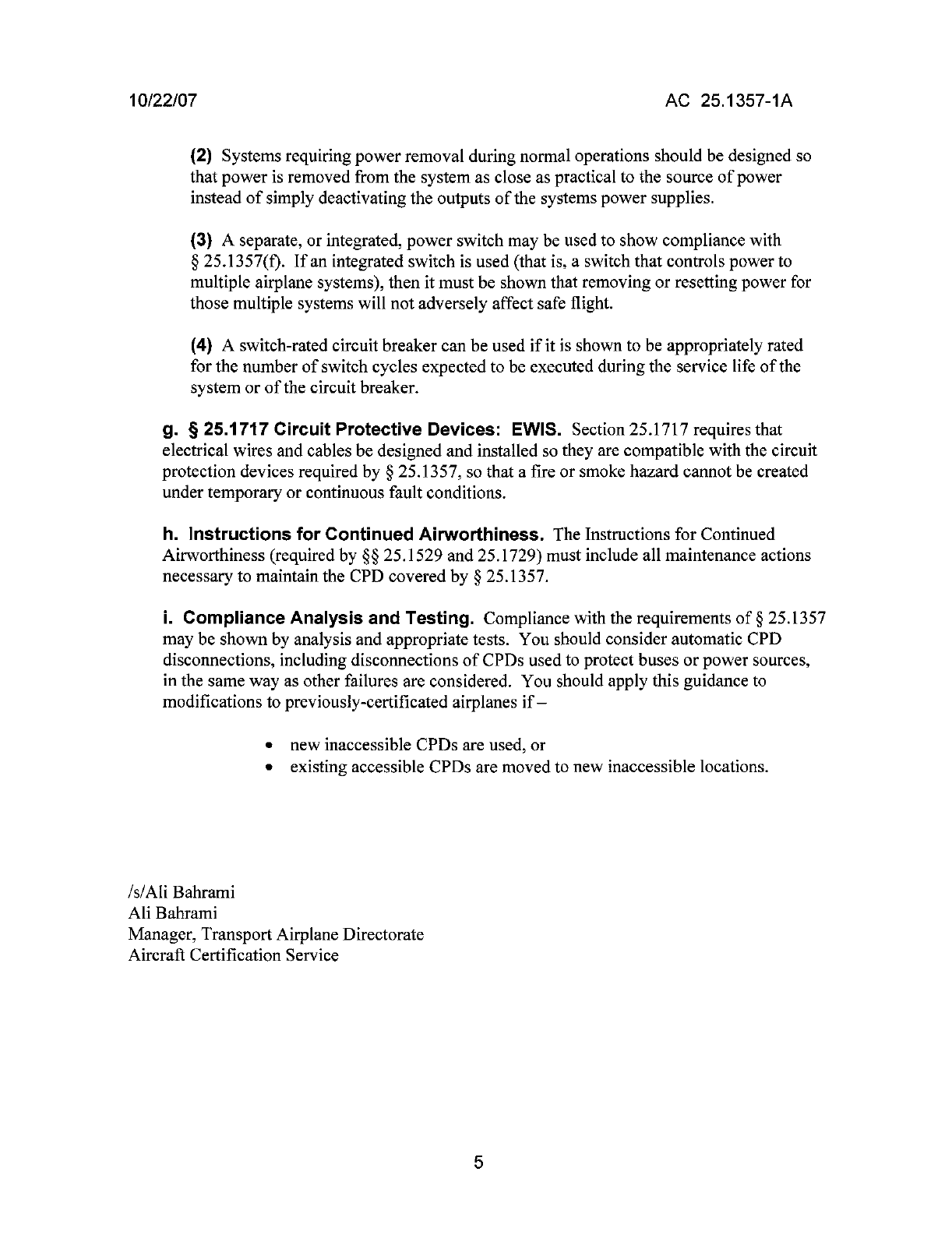
10/22/07 AC 25.1357-1A
(2) Systems requiring power removal during normal operations should be designed so
that power is removed from the system as close as practical to the source of power
instead of simply deactivating the outputs of the systems power supplies.
(3) A separate, or integrated, power switch may be used to show compliance with
§ 25.1357(f). If
an
integrated switch is used (that is, a switch that controls power to
multiple airplane systems), then it must be shown that removing or resetting power for
those multiple systems will not adversely affect safe flight.
(4) A switch-rated circuit breaker can be used if
it
is shown to be appropriately rated
for the number of switch cycles expected to be executed during the service life of the
system or of the circuit breaker.
g. § 25.1717 Circuit Protective Devices: EWIS. Section 25.1717 requires that
electrical wires and cables be designed and installed so they are compatible with the circuit
protection devices required by § 25.1357, so that a fire or smoke hazard cannot be created
under temporary or continuous fault conditions.
h. Instructions for Continued Airworthiness. The Instructions for Continued
Airworthiness (required by §§ 25.1529 and 25.1729) must include all maintenance actions
necessary to maintain the CPD covered by § 25.1357.
i. Compliance Analysis and Testing. Compliance with the requirements of
§
25.1357
may be shown by analysis and appropriate tests. You should consider automatic CPD
disconnections, including disconnections of
CPDs
used to protect buses or power sources,
in the same way as other failures are considered. You should apply this guidance to
modifications to previously-certificated airplanes if-
• new inaccessible CPDs are used, or
• existing accessible CPDs are moved to new inaccessible locations.
/s/AIi
Bahrami
Ali
Bahrami
Manager, Transport Airplane Directorate
Aircraft Certification Service
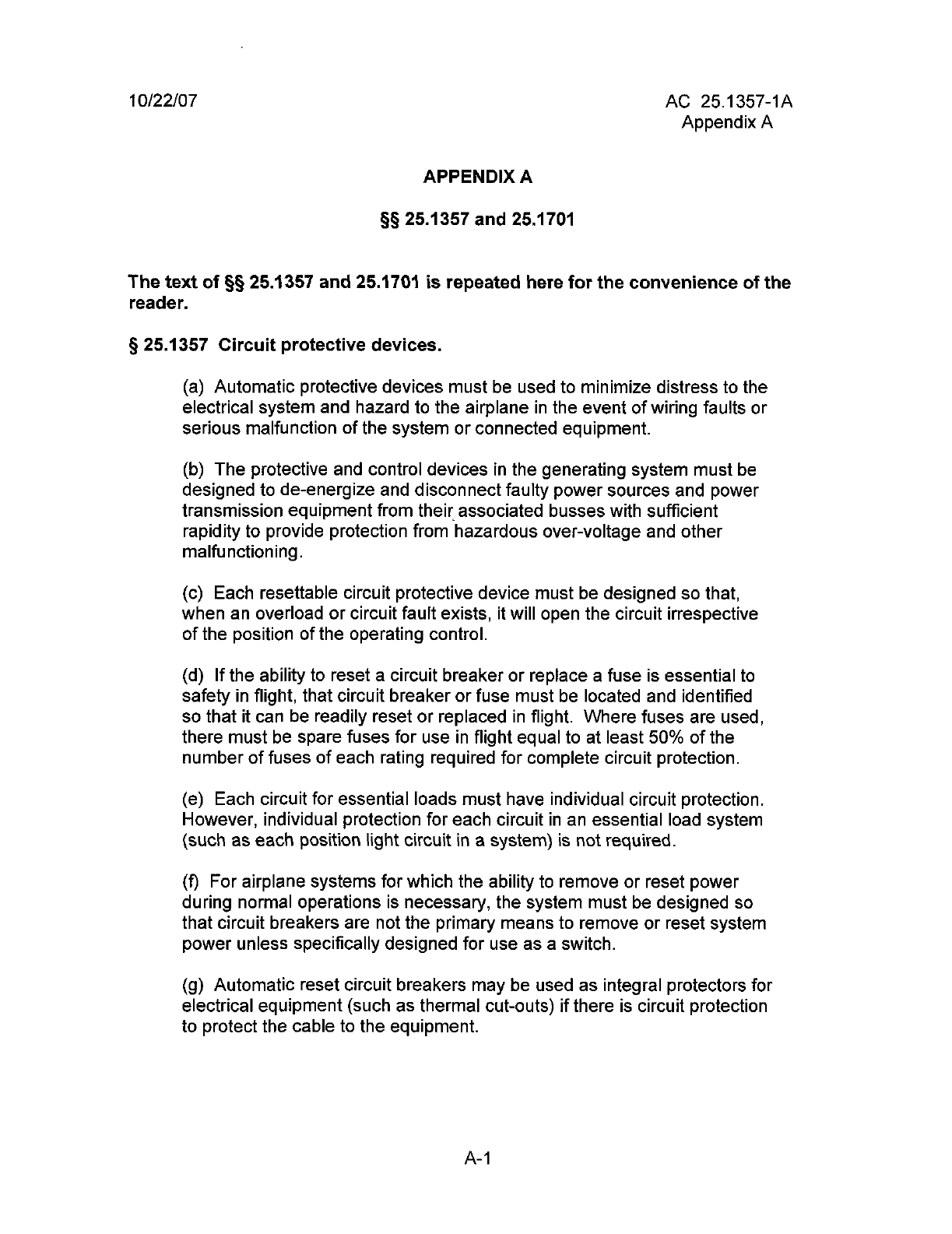
10/22/07 AC 25.1357-1A
Appendix A
APPENDIX A
§§25.1357 and 25.1701
The text of §§ 25.1357 and 25.1701 is repeated here for the convenience of the
reader.
§ 25.1357 Circuit protective devices.
(a) Automatic protective devices must be used to minimize distress to the
electrical system and hazard to the airplane in the event of
wiring
faults or
serious malfunction of the system or connected equipment.
(b) The protective and control devices in the generating system must be
designed to de-energize and disconnect faulty power sources and power
transmission equipment from their associated busses with sufficient
rapidity to provide protection from hazardous over-voltage and other
malfunctioning.
(c) Each resettable circuit protective device must be designed so that,
when an overload or circuit fault exists, it will open the circuit irrespective
of the position of the operating control.
(d) If the ability to reset a circuit breaker or replace a fuse is essential to
safety in flight, that circuit breaker or fuse must be located and identified
so that it can be readily reset or replaced in flight. Where fuses are used,
there must be spare fuses for use in flight equal to at least 50% of the
number of fuses of each rating required for complete circuit protection.
(e) Each circuit for essential loads must have individual circuit protection.
However, individual protection for each circuit in an essential load system
(such as each position light circuit in a system) is not required.
(f) For airplane systems for which the ability to remove or reset power
during normal operations is necessary, the system must be designed so
that circuit breakers are not the primary means to remove or reset system
power unless specifically designed for use as a switch.
(g) Automatic reset circuit breakers may be used as integral protectors for
electrical equipment (such as thermal cut-outs) if there is circuit protection
to protect the cable to the equipment.
A-1
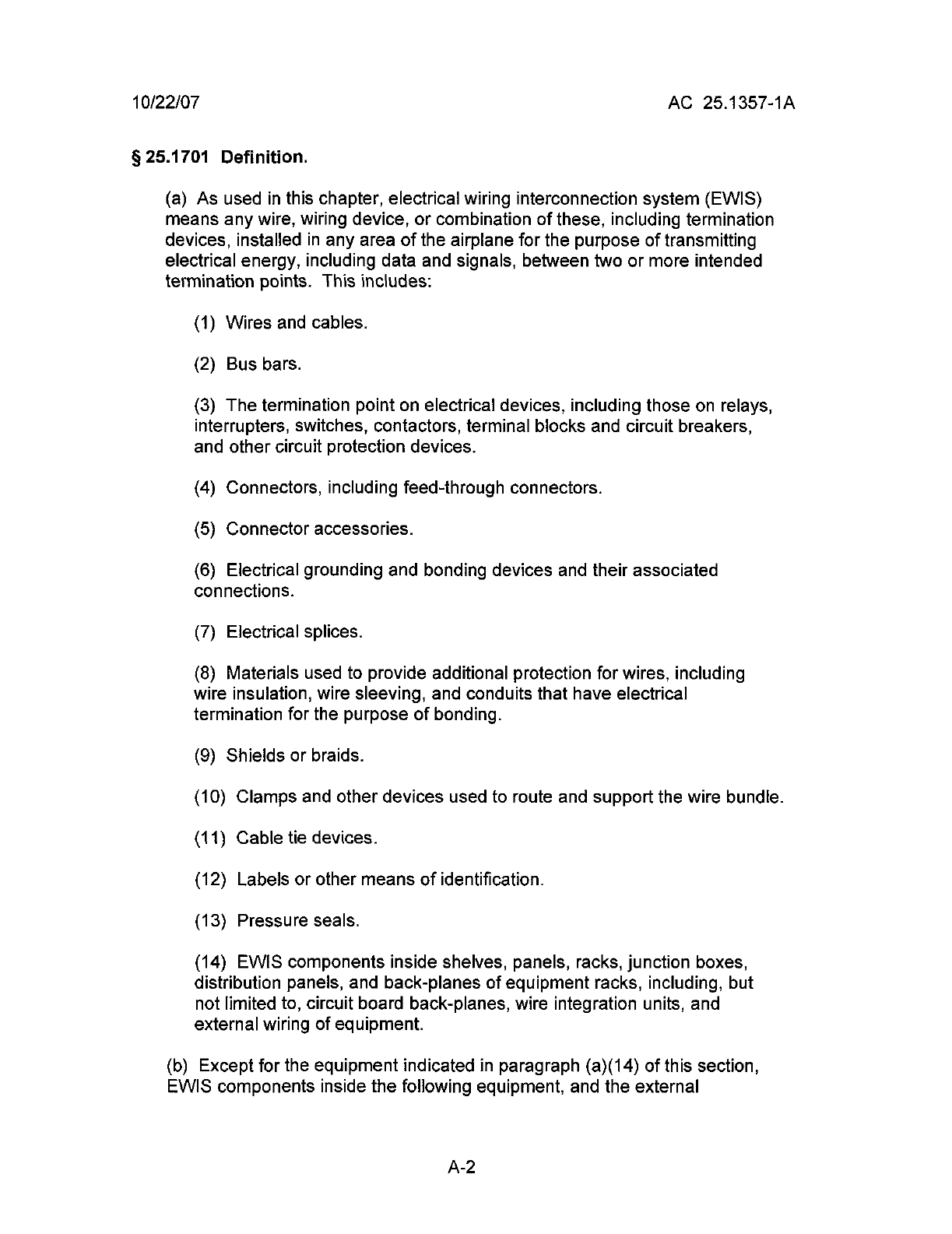
10/22/07 AC 25.1357-1A
§25.1701 Definition.
(a) As used in this chapter, electrical wiring interconnection system (EWIS)
means any
wire,
wiring device, or combination of
these,
including termination
devices, installed in any area of the airplane for the purpose of transmitting
electrical energy, including data and signals, between two or more intended
termination points. This includes:
(1) Wires and cables.
(2) Bus bars.
(3) The termination point on electrical devices, including those on relays,
interrupters, switches, contactors, terminal blocks and circuit breakers,
and other circuit protection devices.
(4) Connectors, including feed-through connectors.
(5) Connector accessories.
(6) Electrical grounding and bonding devices and their associated
connections.
(7) Electrical splices.
(8) Materials used to provide additional protection for
wires,
including
wire insulation, wire sleeving, and conduits that have electrical
termination for the purpose of bonding.
(9) Shields or braids.
(10)
Clamps and other devices used to route and support the wire bundle.
(11)
Cable tie devices.
(12)
Labels or other means of identification.
(13) Pressure seals.
(14) EWIS components inside shelves, panels, racks, junction boxes,
distribution panels, and back-planes of equipment racks, including, but
not limited to, circuit board back-planes, wire integration units, and
external wiring of equipment.
(b) Except
for
the equipment indicated in paragraph (a)(14) of this section,
EWIS components inside the following equipment, and the external
A-2

10/22/07 AC 25.1357-1A
connectors that are part of that equipment, are excluded from the definition
in paragraph (a) of this section:
(1) Electrical equipment or avionics that are qualified to environmental
conditions and testing procedures when those conditions and procedures
are—
(i) appropriate for the intended function and operating environment,
and
(ii) acceptable to the FAA.
(2) Portable electrical devices that are not part of the type design of the
airplane. This includes personal entertainment devices and laptop
computers.
(3) Fiber optics.
A-3
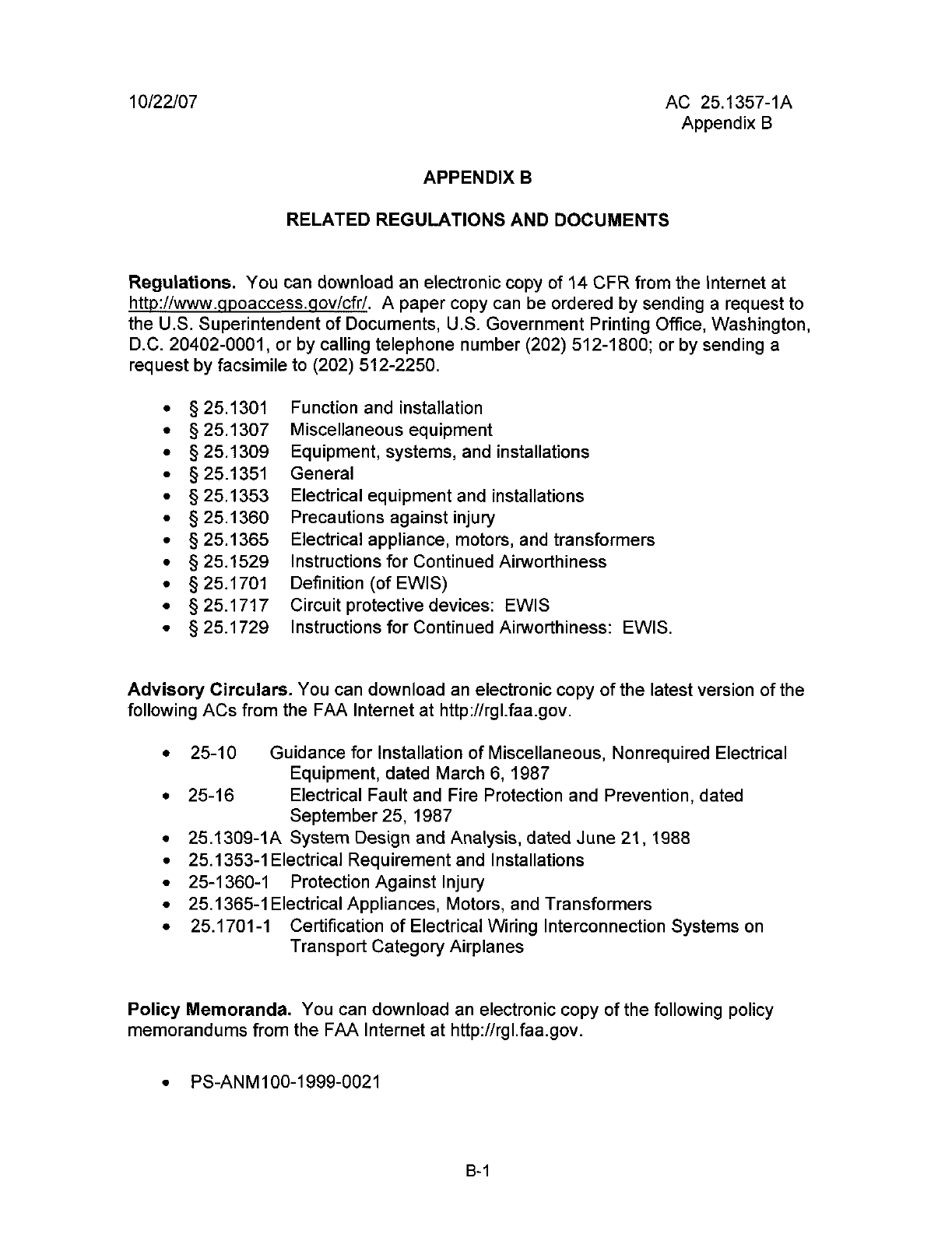
10/22/07 AC 25.1357-1A
Appendix B
APPENDIX B
RELATED REGULATIONS AND DOCUMENTS
Regulations. You can download an electronic copy of 14 CFR from the Internet at
http://www.qpoaccess.gov/cfr/.
A paper copy can be ordered by sending a request to
the U.S. Superintendent of Documents, U.S. Government Printing Office, Washington,
D.C.
20402-0001,
or by calling telephone number (202) 512-1800; or by sending a
request by facsimile to (202) 512-2250.
§ 25.1301 Function and installation
§ 25.1307 Miscellaneous equipment
§ 25.1309 Equipment, systems, and installations
§25.1351 General
§ 25.1353 Electrical equipment and installations
§ 25.1360 Precautions against injury
§
25.1365
Electrical appliance, motors, and transformers
§ 25.1529 Instructions for Continued Airworthiness
§
25.1701
Definition (of EWIS)
§ 25.1717 Circuit protective devices: EWIS
§
25.1729
Instructions for Continued Airworthiness: EWIS.
Advisory Circulars. You can download an electronic copy of the latest version of the
following ACs from the FAA Internet at http://rgl.faa.gov.
• 25-10 Guidance for Installation of Miscellaneous, Nonrequired Electrical
Equipment, dated March 6, 1987
• 25-16 Electrical Fault and Fire Protection and Prevention, dated
September
25,
1987
• 25.1309-1A System Design and Analysis, dated June
21,
1988
•
25.1353-1
Electrical Requirement and Installations
•
25-1360-1
Protection Against Injury
•
25.1365-1
Electrical Appliances, Motors, and Transformers
•
25.1701-1
Certification of Electrical Wiring Interconnection Systems on
Transport Category Airplanes
Policy Memoranda. You can download an electronic copy of the following policy
memorandums from the FAA Internet at http://rgl.faa.gov.
• PS-ANM100-1999-0021
B-1

10/22/07 AC 25.1357-1A
Appendix B
Requirements of FAR 25.1357(e), issued April 20, 1999
•
PS-ANM100-2000-00105
(also numbered
00-111-160)
Interim Policy Guidance for Certification of
In-Flight
Entertainment Systems on
Title
14 CFR Part
25 Aircraft, issued September 18, 2000
•
PS-ANM100-2001-00113
(also numbered 00-111-196)
Interim Summary of Policy and Advisory Material Available for Use in the
Certification of Cabin Mounted Video Camera Systems with flight Deck
Displays on Title 14 CFR Part 25 Aircraft, issued October 5, 2001
•
ANM-01-111-165
Policy Statement on Certification of Power Supply systems for Portable
Electronic Devices on Part 25 Airplanes, issued March 28, 2005
Reports. You can download an electronic copy of the following report from the "Final
Reports" section of the ATSRAC website: www.mitrecaasd.org/atsrac.
"Task 6 Final Report," dated October
29,
2002, Aging Transport Systems
Rulemaking Advisory Committee
B-2
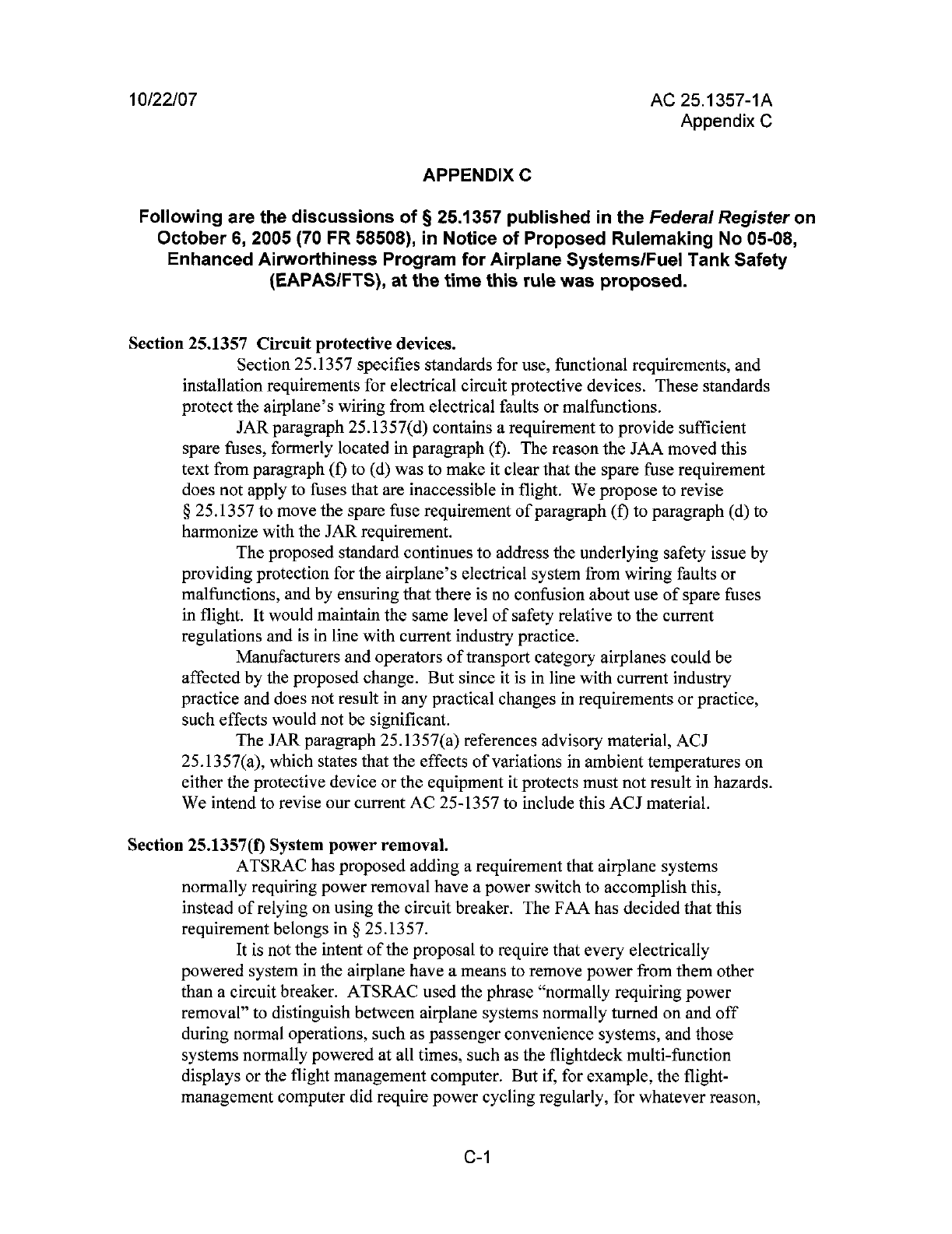
10/22/07
AC25.1357-1A
Appendix C
APPENDIX C
Following are the discussions of §
25.1357
published in the Federal Register on
October 6, 2005 (70 FR 58508), in Notice of Proposed Rulemaking No 05-08,
Enhanced Airworthiness Program for Airplane Systems/Fuel Tank Safety
(EAPAS/FTS), at the time this rule was proposed.
Section 25.1357 Circuit protective devices.
Section 25.1357 specifies standards for use, functional requirements, and
installation requirements for electrical circuit protective devices. These standards
protect the airplane's wiring from electrical faults or malfunctions.
JAR paragraph 25.1357(d) contains a requirement to provide sufficient
spare fuses, formerly located in paragraph (f). The reason the JAA moved this
text from paragraph (f) to (d) was to make it clear that the spare fuse requirement
does not apply to fuses that are inaccessible in flight. We propose to revise
§ 25.1357 to move the spare fuse requirement of paragraph (f) to paragraph (d) to
harmonize with the JAR requirement.
The proposed standard continues to address the underlying safety issue by
providing protection for the airplane's electrical system from wiring faults or
malfunctions, and by ensuring that there is no confusion about use of
spare
fuses
in flight. It would maintain the same level of safety relative to the current
regulations and is in line with current industry practice.
Manufacturers and operators of transport category airplanes could be
affected by the proposed change. But since it is in line with current industry
practice and does not result in any practical changes in requirements or practice,
such effects would not be significant.
The JAR paragraph 25.1357(a) references advisory material, ACJ
25.1357(a), which states that the effects of variations in ambient temperatures on
either the protective device or the equipment it protects must not result in hazards.
We intend to revise our current AC 25-1357 to include this ACJ material.
Section 25.1357(f) System power removal.
ATSRAC has proposed adding a requirement that airplane systems
normally requiring power removal have a power switch to accomplish this,
instead of relying on using the circuit breaker. The FAA has decided that this
requirement belongs in § 25.1357.
It is not the intent of the proposal to require that every electrically
powered system in the airplane have a means to remove power from them other
than a circuit breaker. ATSRAC used the phrase "normally requiring power
removal" to distinguish between airplane systems normally turned on and off
during normal operations, such as passenger convenience systems, and those
systems normally powered at all times, such as the flightdeck multi-function
displays or the flight management computer. But if, for example, the flight-
management computer did require power cycling regularly, for whatever reason,
C-1
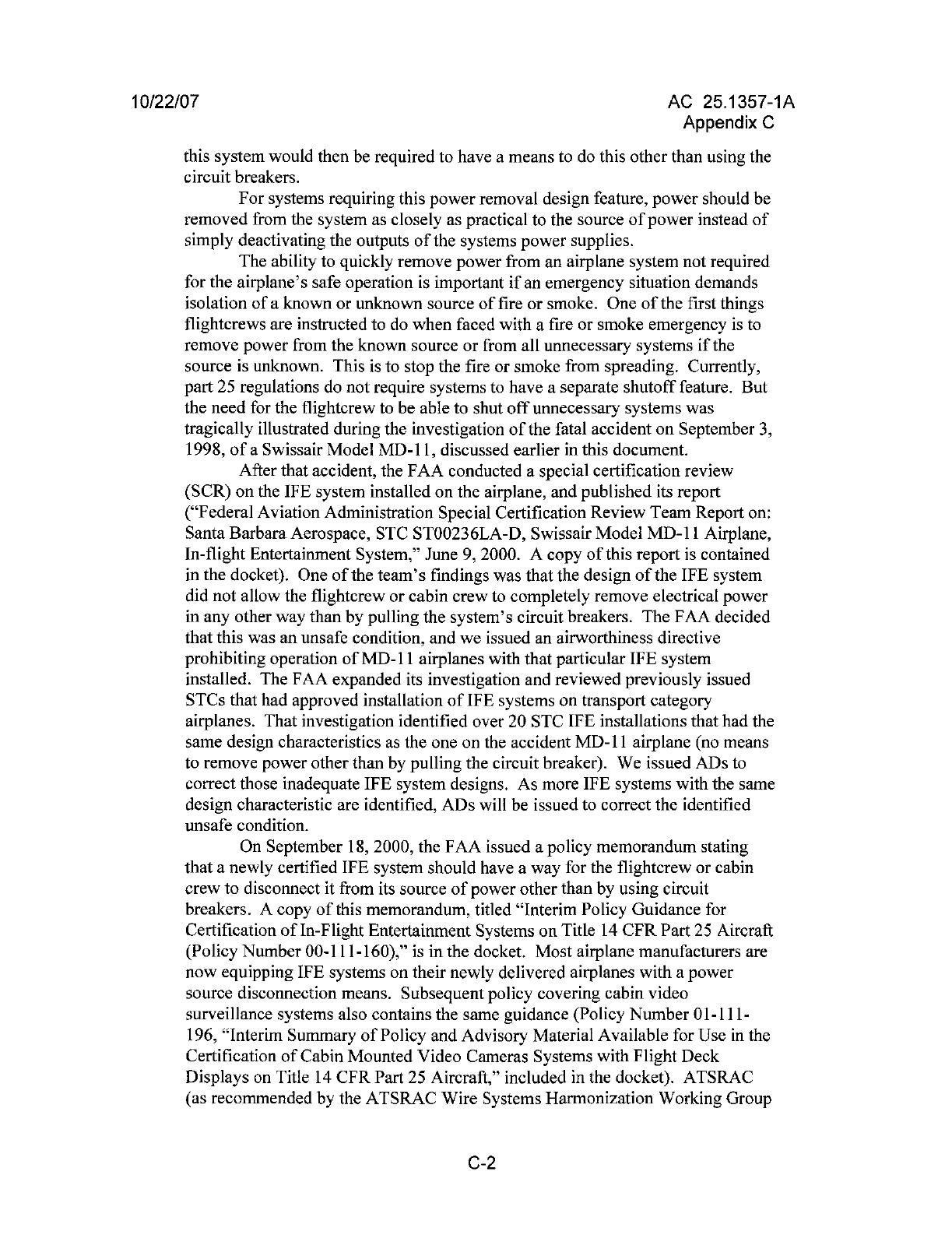
10/22/07 AC
25.1357-1A
Appendix C
this system would then be required to have a means to do this other than using the
circuit breakers.
For systems requiring this power removal design feature, power should be
removed from the system as closely as practical to the source of power instead of
simply deactivating the outputs of the systems power supplies.
The ability to quickly remove power from an airplane system not required
for the airplane's safe operation is important if
an
emergency situation demands
isolation of
a
known or unknown source of fire or smoke. One of the first things
flightcrews are instructed to do when faced with a
fire
or smoke emergency is to
remove power from the known source or from all unnecessary systems if the
source is unknown. This is to stop the fire or smoke from spreading. Currently,
part 25 regulations do not require systems to have a separate
shutoff
feature. But
the need for the flightcrew to be able to shut off unnecessary systems was
tragically illustrated during the investigation of the fatal accident on September 3,
1998,
of
a
Swissair Model
MD-11,
discussed earlier in this document.
After that accident, the FAA conducted a special certification review
(SCR) on the IFE system installed on the airplane, and published its report
("Federal Aviation Administration Special Certification Review Team Report on:
Santa Barbara Aerospace, STC ST00236LA-D, Swissair
Mode!
MD-11
Airplane,
In-flight Entertainment System," June 9, 2000. A copy of this report is contained
in the docket). One of the team's findings was that the design of the IFE system
did not allow the flightcrew or cabin crew to completely remove electrical power
in any other way than by pulling the system's circuit breakers. The FAA decided
that this was an unsafe condition, and we issued an airworthiness directive
prohibiting operation of
MD-11
airplanes with that particular IFE system
installed. The FAA expanded its investigation and reviewed previously issued
STCs that had approved installation of
IFE
systems on transport category
airplanes. That investigation identified over 20 STC IFE installations that had the
same design characteristics as the one on the accident
MD-11
airplane (no means
to remove power other than by pulling the circuit breaker). We issued ADs to
correct those inadequate IFE system designs. As more IFE systems with the same
design characteristic are identified, ADs will be issued to correct the identified
unsafe condition.
On September 18, 2000, the FAA issued a policy memorandum stating
that a newly certified IFE system should have a way for the flightcrew or cabin
crew to disconnect it from its source of power other than by using circuit
breakers. A copy of this memorandum, titled "Interim Policy Guidance for
Certification of In-Flight Entertainment Systems on Title 14 CFR Part
25
Aircraft
(Policy Number
00-111-160),"
is in the docket. Most airplane manufacturers are
now equipping IFE systems on their newly delivered airplanes with a power
source disconnection means. Subsequent policy covering cabin video
surveillance systems also contains the same guidance (Policy Number
01-111-
196,
"Interim Summary of Policy and Advisory Material Available for Use in the
Certification of Cabin Mounted Video Cameras Systems with Flight Deck
Displays on Title 14 CFR Part 25 Aircraft," included in the docket). ATSRAC
(as recommended by the ATSRAC Wire Systems Harmonization Working Group
C-2
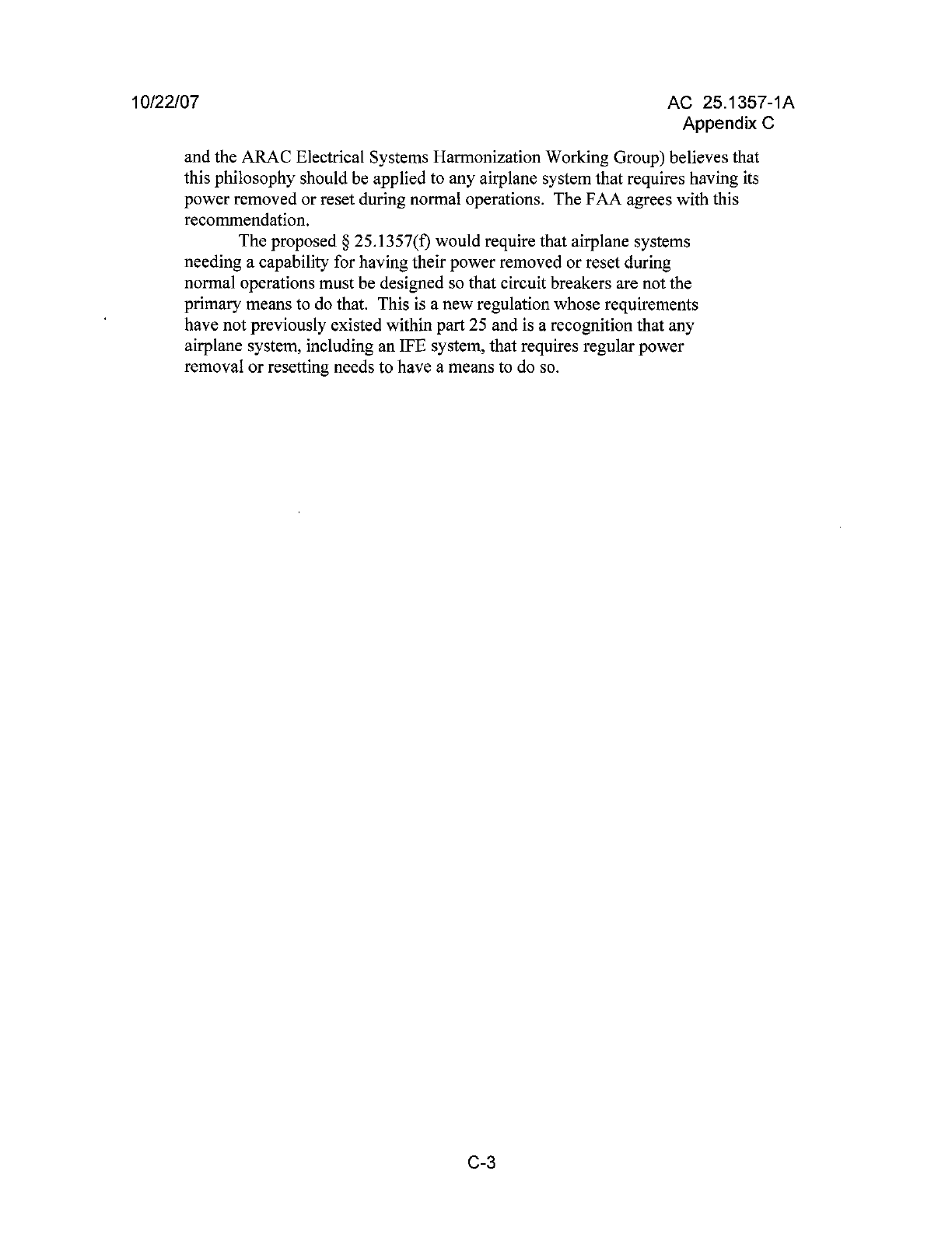
10/22/07 AC 25.1357-1A
Appendix C
and the ARAC Electrical Systems Harmonization Working Group) believes that
this philosophy should be applied to any airplane system that requires having its
power removed or reset during normal operations. The FAA agrees with this
recommendation.
The proposed § 25.1357(f) would require that airplane systems
needing a capability for having their power removed or reset during
normal operations must be designed so that circuit breakers are not the
primary means to do that. This is a new regulation whose requirements
have not previously existed within part 25 and is a recognition that any
airplane system, including an IFE system, that requires regular power
removal or resetting needs to have a means to do so.
C-3
